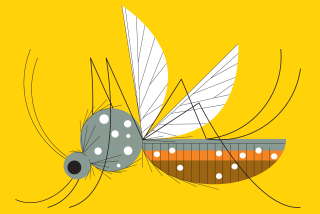‘Natural’ insect repellents are plentiful but not always reliable
Consumers now have an array of “natural” insect repellents from which to choose. These are made from benign-sounding plant extracts or oils such as citronella oil, soybean oil, peppermint oil, cedarwood oil, lemon grass oil and geranium oil. What consumers don’t always have is proof that they work.
Many natural insect repellents, deemed “minimum-risk pesticides” by the Environmental Protection Agency, are exempt from safety testing because their active and inert ingredients have been deemed safe for the intended use.
These ingredients have been used for long enough in consumer products that they’re generally regarded as safe, says Scott Carroll, director of Carroll-Loye Biological Research Consulting, an independent company that does extensive testing on insect repellents.
For instance, the synthetic form of vanilla is often used in pesticidal products because it helps catalyze the active ingredients. “[Vanillin] is in every sugar cookie anyone has ever eaten, so that’s why it’s not regulated,” Carroll says.
Not only do these minimum-risk natural products not require safety testing, companies that market them are also not required to demonstrate how well they work.
Products called ‘safe’
“To me, [minimum risk pesticides] is code for: ‘They don’t work very well,’” says Dennis Tracz, founder of a company that makes a pine-oil based repellent. Many of the chemicals found in herbal repellents are highly volatile, so they evaporate quickly. “It’s not that they’re not effective, it’s just that they don’t last very long.”
There are currently hundreds of products on the market that are exempt from testing because of their minimum-risk status. “It’s just cheaper and easier to get that designation than to go through full [EPA] registration,” Tracz says.
The EPA is the agency responsible for evaluating safety studies of insect repellents, and it also reviews data from third-party labs such as Carroll’s that do independent testing of product efficacy. One of the reasons that the EPA was tasked with overseeing insect repellents, rather than the Food and Drug Administration, is that pesticides already fall under its purview.
But pesticides are generally not intended for personal human use. To get that mechanism turned around for products actually intended to be put on your body is not a very smooth process, says Carroll, also an evolutionary biologist at UC Davis.
Among the products that use ingredients from the EPA’s minimum-risk list are Burt’s Bees Herbal Insect Repellent, Buzz Away and Natural Herbal Armor.
“Many of the essential oil-based natural repellents on the market are short-lived,” Carroll says. “We find tremendous variation [in how well they work among different people] — it’s really fascinating. Anywhere from five minutes to three hours.”
Powerful botanicals
Oil of lemon eucalyptus is one of the few natural-based repellents subject to EPA’s strict testing. Sold under the trade name Citriodiol (no relation to citronella), it’s been proved effective in laboratory tests at repelling insects for six hours or even longer, depending on the formulation. Citriodiol can be found in a number of brands, including Repel, Cutter and, new in 2011, Coleman Botanicals.
The repellent in which it’s used is actually a hybrid natural/synthetic product. “We don’t claim to be pure natural — that would be essential oils like lavender oil,” says Genevieve Faherty, regulatory affairs director for Citrefine. “But it’s really as close to natural as you can get.” Citriodiol-based products usually cost a few dollars more than the standard DEET-based products.
Because it is based on a natural product, Citriodiol has lower testing requirements than synthetic products such as DEET. But because Citriodiol hasn’t been put through the same toxicity testing as synthetic products, its safety on infants and pregnant women has not been proved.
Faherty says that the product is undergoing reproductive safety testing in Europe.
Another natural product that experts believe holds great promise is the pine-oil derivative that Tracz’s company, 141 Repellent Inc., is developing.
In a 2009 study in the Journal of Medical Entomology, Aijun Zhang, a research chemist with the U.S. Department of Agriculture, and his colleagues found that isolongifolenone, a natural product derived from pine oil that has been used safely in the cosmetic industry for about 40 years, deterred biting mosquitoes and repelled ticks more effectively than DEET.
“It does look as if this organic repellent functions pretty much at an equal level with DEET, maybe even better,” says Donald Roberts, a retired professor of tropical public health at the Uniformed Services University of the Health Sciences in Bethesda, Md. “Until we have a lot more test data, it would be hard to give a definitive statement on that, but I would say that it shows real promise.”
Pine oil promise
The company is working on its EPA registration status, and Tracz hopes that the pine-oil derivative could be on the market within 18 months. “DEET is very effective compared to everything available on the market, which is why people keep buying it despite potential risks,” says Tracz. “We believe our alternative, natural product will bring this issue to an end because ours will be cost-effective and will work great and be safe as well.”
The pine-oil derivative has also tested positive for its ability to work well as a “spatial repellent,” which means that it can be sprayed on the walls of homes and on bed nets to fend off mosquitoes. Currently, no chemical registered for use in malaria control functions as a spatial repellent aside from the infamous DDT.
Tracz hopes that his company’s natural pine-oil derivative will be the first non-toxic alternative to DDT, and he believes it could change the face of disease control in the developing world. The name of his company, 141 Repellent, is based on a business model that means just that: one for one. For every bottle the company sells, it will donate one malaria treatment for a bed net in the developing world.
The repellent could be used to treat curtains, fabrics, rugs — it could even be added to paint, he says. “The commercial side is just going to be my vehicle to get me there.”
More to Read
Inside the business of entertainment
The Wide Shot brings you news, analysis and insights on everything from streaming wars to production — and what it all means for the future.
You may occasionally receive promotional content from the Los Angeles Times.










